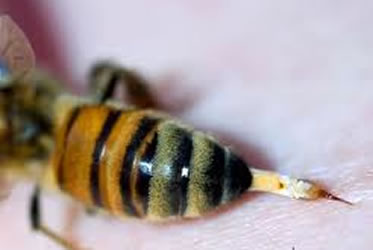Honey Bee Products - Bee Venom
Sourced from http://en.wikipedia.org/wiki/Apitoxin
- Apitoxin, or honey bee venom, is a bitter colorless liquid.
- The active portion of the venom is a complex mixture of proteins, which causes local inflammation and acts as an anticoagulant.
- The venom is produced in the abdomen of worker bees from a mixture of acidic and basic secretions.
- Apitoxin is acidic (pH 4.5 to 5.5).
- A honeybee can inject 0.1 mg of venom via its stinger.
- Apitoxin is similar to nettle toxin.
- It is estimated that 1% of the population is allergic to bee stings.
- Apitoxin can be deactivated with ethanol.
- Bee venom therapy is used by some as a treatment for rheumatism and joint diseases due to its anticoagulant and anti-inflammatory properties.
- It is also used to desensitize people allergic to insect stings.
- Bee venom therapy can also be delivered in the form of Bee Venom Balm although this may be less potent than using live bee stings.
The treatment use of honey bee venom therapy is based on the long-known fact that bee-keepers (who often get stung) very rarely develop arthritis or problems with their joints and muscles.
Bee Venom Masks
The Bee Venom contained in Bee Venom Masks is used to fool the skin into thinking it has been lightly stung. This in turn stimulates the production of the naturally occurring chemicals collagen and elastin, creating a tightening and smoothing effect. The effects are cumulative, the longer you use it the more obvious the effects will be. A tautening effect can generally be felt soon after application.
Kate Middleton, Dannii Minogue, Michelle Pfeiffer, Gwyneth Paltrow and many others are reported to be using a Bee Venom Face Mask made from New Zealand Bee Venom.

